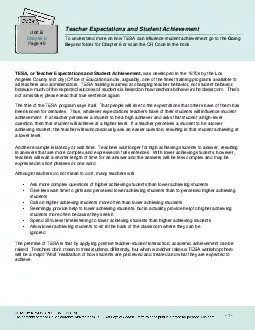

sand Student Achievementwas developed in the 1970s by the Los Angeles County not city Office of Education and is arguably one of the finest training programs available to all teachers and administrato ID: 867136
Download Pdf The PPT/PDF document "TESA or Teacher Expectation" is the property of its rightful owner. Permission is granted to download and print the materials on this web site for personal, non-commercial use only, and to display it on your personal computer provided you do not modify the materials and that you retain all copyright notices contained in the materials. By downloading content from our website, you accept the terms of this agreement.
1 TESA, or Teacher Expectation s and Stu
TESA, or Teacher Expectation s and Student Achievement, was developed in the 19 70s by the Los Angeles County (not city) Office of Education and is, arguably, one of the finest training programs available to all teachers and administrators . TESA training is aimed at changing teacher behavior, not student behavior , not a mis take; please read that true sentence again. The title of the TESA program says it all. That people will rise to the expectations that others have of them has been known for centuries. Thus, w hatever expectations teachers have of their students will influence student achievement. If a teacher perceives a student to be a high achiever and asks that student a high - l evel question, then that student will achieve at a higher level. If a teacher perceives a student to be a lower achieving student, the teacher will subconsciously ask an easier question, resulting in that student achieving at a lower level. Another example is latency or wait time. Teachers wait longer for high achieving students to answer , resulting in an expressed in full sentences. With lower achieving student s, however, teachers will wait a shorter length of time for a n answer and the answers will be less complex and may be expressed in short phrases or one word. Although teachers do not mean to do it, many teachers will Ask more complex questions of higher achieving students than lower achieving students Give less wait time to girls and perceived lower achieving studen ts than to perceived higher achieving students Call on higher achieving students more often than lower achieving students Seemingly provide help to lower achieving students, but in actuality provide help to higher achieving students more often because th ey seek it Spend 25% less time listening to lower achieving students than higher achieving students Allow lower achieving students to sit in the back of the classroom where they can be ignored The premise of TESA is that by applying positive teacher - student interaction, academic achievement can be raised. Teachers don’t mean to treat students differently, but when a teacher takes a TESA workshop there will be a major “ Aha !” realization of w students are perceived and treated and what they are expected to achieve . Teacher Expectations and Student Achievement To understand more on how TESA can influence student achievement go to the Go ing Be yond folder for Chapter 6 or scan the QR Code in the
2 book. Unit B Chapter 6 Page 49
book. Unit B Chapter 6 Page 49 - 1 - TESA is based on the belief that the surest way to create change is to change ourselves. TESA is structured to increase teacher awareness of their perceptions and how their perceptions of both high and low achieving students affect their expectations of them . TESA is concerned not just with the quantity of i nteractions, but also with The program is based on expectation theory and the research of Thomas Good and Jere Brophy . It is structured on fifteen behaviors designed to encourage equitable interaction with all students. 1. Equitable Distribution of Response Opportunity : The teacher learns how to provide equal opportunity for all students to respond or perform in the classroom. 2. Correction: The teacher learns how to give equal feedback to students about their classroom performance. 3. Proximity: The teacher learns the importance of providing equal proximity to students as they work. 4. Individual Helping: The teacher learns how to provide equal help to each student. 5. Praise for the Learning Performance: each student ’s learning performance. 6. Courtesy : The teacher learns how to use expressions of courtesy in interactions with students. 7. Latency : The teacher learns how to allow student s enough time to think over question s before assisting or ending the opportunity to respond. 8. Reasons for Praise: The teacher learns how to give useful feedbac k to enhance students' learning performance. 9. Personal Interest Statements and Compliments : The teacher learns how to ask questions and give compliments relating to student s’ 10. Delving, Rephrasing, Giving Clues : The teacher learns how to provide additional information to help student s respond to a question. 11. Listening : The teacher learns how to apply active listening techniques with students. 12. Touching : The teacher learns how to touch students in a respectful, appropriate , and friendly manner. (This research was done in 1970 and may not be appropriate today.) 13. Higher - Level Questioning : The teacher learns how to ask challenging questions that require students to do more than simply recall informati on . 14. Accepting Feelings: - evaluative manner. 15. Desisting : The teacher learns how to stop a student's misbehavior in a calm and courteous manner. - 2 - Teacher Expectations and Student Achievement (continued